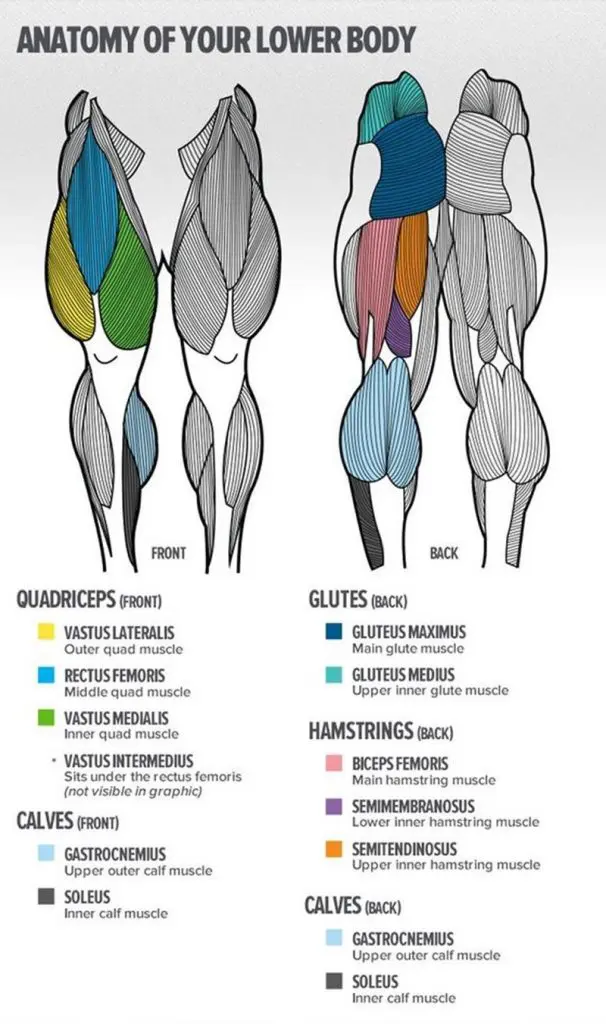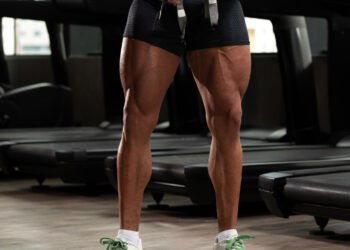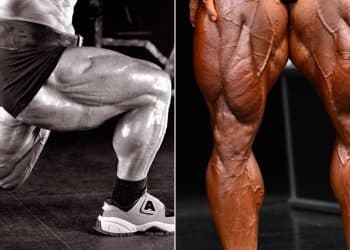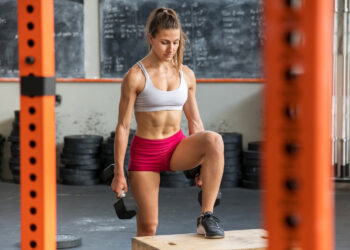When it comes to exercises that offer a lot of bang for their buck, deadlifts are amongst the best. Deadlifts work virtually every muscle in your lower body, and a great many upper body muscles too. They’re good for building both muscle mass and strength and can even increase endurance and boost athleticism.
The conventional deadlift is hard to beat, but you don’t have to limit yourself to that one variation. There are other types of deadlifts to choose from, including the sumo deadlift, snatch grip deadlifts, Romanian deadlifts, and deadlifts from blocks.
Another less used variation is suitcase deadlifts. This unique exercise is a worthy addition to your training toolbox.
Muscles Worked
Suitcase deadlifts are pretty much a full-body exercise. That said, it IS possible to identify the major muscles involved.

Those muscles are:
Level Up Your Fitness: Join our 💪 strong community in Fitness Volt Newsletter. Get daily inspiration, expert-backed workouts, nutrition tips, the latest in strength sports, and the support you need to reach your goals. Subscribe for free!
Quadriceps– located on the front of your thighs, and known as your quads for short, these muscles are responsible for extending your knee joint.
Hamstrings– responsible for knee flexion and hip extension, your hamstrings are located on the back of your thigh.
Gluteus maximus– also known as your glutes, this muscle is basically your butt. Its primary function is the extension of the hip joint. The gluteus maximus is the largest muscle in the human body.
Erector spinae– the collective term for the muscles of your lower back. The erector spinae works hard to keep your spine rigid while your lower body muscles generate force and lift the weight.
Core– the collective term for the muscles that make up your midsection, your core is your body’s natural weight training belt. It helps support your spine and keep it rigid. Muscles that make up the core include the rectus abdominus, obliques, transverse abdominus, pelvic floor, and diaphragm. Suitcase deadlifts are especially hard on your obliques.
Latissimus dorsi– known as your lats for short, these are the muscles on the side of your back. Their main functions are shoulder extension and adduction.
Trapezius– this is the kite-shaped muscle of your upper back. Suitcase deadlifts involve your upper and middle trapezius, whose functions are shoulder girdle elevation and retraction.
Forearm flexors– the muscles in your forearm responsible for maintaining your grip during suitcase deadlifts.
How To Do The Suitcase Deadlift
To get the most from suitcase deadlifts, you must do them correctly. The correct technique will ensure you get the most from this great exercise while keeping your risk of injury to an absolute minimum.
Start with a light weight when learning this or any new exercise. Perfect your technique before adding weight.
How to do it:
- Place a dumbbell on the floor and stand next to it so that the handle runs parallel to your feet. Stand with your feet about hip-width apart.
- Squat down and grip the dumbbell with an overhand grip, so your thumb is pointing forward. Straighten your arm.
- Drop your hips, lift your chest, and slightly arch your lower back. Look straight ahead and brace your abs.
- Without rounding your back or leaning to the side, drive your feet into the floor and stand up. Keep your abs braced, working hard to keep your torso perfectly upright.
- Push your hips back, bend your knees, and lower the weight smoothly back to the floor. Reset your core and repeat.
- Rest a moment at the end of your set and then swap sides. Try to do the same number of reps on each side.
If you have poor flexibility and find that your lower back tends to round when doing this exercise, place the dumbbell on a 6 to 12-inch step to raise it up and reduce your range of motion. This will make it easier to maintain an arched lower back.
The benefits of suitcase deadlifts
There are lots of reasons to include suitcase deadlifts in your workouts, including:
Increased lateral core activation – done with just one dumbbell, suitcase deadlifts put a lot more stress on one side of your core than the other. This is an excellent way to strengthen your lateral core muscles, specifically your obliques.
Identify and fix left-to-right strength imbalances – while it’s normal to have one side stronger than the other, if that strength imbalance becomes too noticeable, it could lead to injury. Suitcase deadlifts are an excellent way to spot and correct such imbalances.
Build a firmer grip – with conventional deadlifts, you can use a mixed grip to stop the bar rolling out of your fingers. One-handed suitcase deadlifts offer no such advantage, which means you’ll really need to hold on tight to avoid dropping the weight. This will strengthen your grip.
Increased functional carryover – suitcase deadlifts are so-called because they resemble bending down to pick up a heavy bag with one hand. Strength built in the gym with suitcase deadlifts will make this common task feel a whole lot easier.
Variety – if you always do the same exercises, your progress will soon stall. Adding suitcase deadlifts to your workouts will provide your body with a new challenge, and that will ensure you continue to make progress.
Level Up Your Fitness: Join our 💪 strong community in Fitness Volt Newsletter. Get daily inspiration, expert-backed workouts, nutrition tips, the latest in strength sports, and the support you need to reach your goals. Subscribe for free!
A better conventional deadlift – with the weight on one side of your body, during suitcase deadlifts you have to work extra hard to stabilizer your spine and control your posture. This should have a beneficial knock-on effect on your conventional deadlifts, increasing core stability, balance, and improving symmetry.
Suitcase deadlift variations
Suitcase deadlifts are a variation of conventional deadlifts. However, there are variations of suitcase deadlifts you can try too. Here are a few different options you can use to add even more variety to your workouts.
1. Barbell suitcase deadlifts
Performed as above but using a barbell instead of a dumbbell. The barbell is longer, so you’ll need to work harder to keep the weight stable, increasing forearm, and core activation.
2. Kettlebell suitcase deadlifts
Performed as above but using a kettlebell instead of a dumbbell. Kettlebell handles are usually thicker than dumbbell handles, which makes them harder to grip.
3. Double dumbbell suitcase deadlift
For this variation, use two dumbbells instead of one. Using two dumbbells will make it easier to balance, reducing lateral core activation, but mean you’ll be able to lift heavier loads to overload your legs.
4. Deficit suitcase deadlifts
Increase your range of motion and the difficulty of this exercise by standing on a 2 to 6-inch high platform. Only attempt this variation of you have good flexibility and mobility and can already do regular suitcase deadlifts using perfect technique.
5. Suitcase deadlift and farmer’s walk
After picking up your dumbbell, take a walk around your training area until you feel your grip starting to fail. Lower the weight down the floor, swap sides, and repeat. This is a good core, forearm, and conditioning exercise.
Important Suitcase Deadlift Training Tips
Get even more from this exercise with these handy tips!
Use chalk – with no way to use a mixed grip, your hands may slip while you are doing this exercise. Avoid this problem by using chalk to soak up any sweat. If your gym does not allow the use of chalk, make sure you wipe your hands on a towel immediately before each set.
Learn to use a hook grip – a hook grip is a simple, if somewhat painful way to strengthen your grip. To do the hook grip, tuck your thumb inside your first two fingers. This increases friction and should stop your hands from failing mid-rep.
Do suitcase deadlifts in front of a mirror – leaning over to one side will make this exercise less effective. While you might be able to feel a big lean, a small lateral deviation may not be so obvious. Do this exercise in front of a mirror so that you can see and correct any sideways leans.
Video your workout – still not sure if you have mastered the suitcase deadlift? Ask a friend to video you from the front, side, and back to check your performance.
Warm-up before working out – suitcase deadlifts involve a large range of motion. If you try to do them before warming up, you could end up injured. Reduce your risk of injury and increase your performance by warming up before going too heavy with this exercise. A few minutes of light cardio, followed by some dynamic stretches and joint mobility exercises, will suffice. Finish your warm-up with 1-3 light sets of suitcase deadlifts, focusing on using perfect technique.
Common Mistakes
Make your workouts safer and more productive by avoiding these common mistakes.
Not bracing your core – you MUST brace your core tightly to do this exercise successfully. If you don’t, the weight will pull you over to one side, increasing your risk of injury. Tense your abs like you’re expecting to get punched in the gut and maintain that tension throughout your set.
Going too deep – if you use small dumbbells and start from the floor, suitcase deadlifts can involve a very long range of motion. That’s okay if you have above-average flexibility or aren’t too tall. But if you are inflexible or long-limbed, you may struggle to keep your back arched. Reduce the range of motion by using a kettlebell or placing your weight on a low platform.
Going too heavy too soon – just because you can lift heavy weights while doing conventional deadlifts doesn’t mean you should jump straight into heavy suitcase deadlifts. The demands of suitcase deadlifts are quite unique, and lifting just one weight at a time increases the strain on your lumbar spine. Work on your technique first, and then, when you feel ready, gradually start to increase the weight.
Letting the weight pull you off-center – leaning sideways with a heavy weight in your hand is a good way to hurt your lower back. Check your posture in the mirror and make sure you aren’t leaning to the left or the right.
Not keeping your hips and shoulders square – in the same way you need to avoid leaning sideways during suitcase deadlifts, you should also avoid twisting your hips or shoulders. Instead, keep your core braced and your body correctly aligned. This makes suitcase deadlifts safer and more effective.
Wrapping Up
Suitcase deadlifts are a uniquely challenging exercise that you can do in place or alongside conventional deadlifts. They are as much a core exercise as they are a leg exercise, which is good news if you are running short of time and want to train more muscle groups with fewer exercises.
While they can take a while master, suitcase deadlifts are a very versatile exercise, and you can use them to build muscle, increase your strength, increase your endurance, or even burn fat.
Add some variety to your core and leg workouts with suitcase deadlifts; you’re going to love them!








